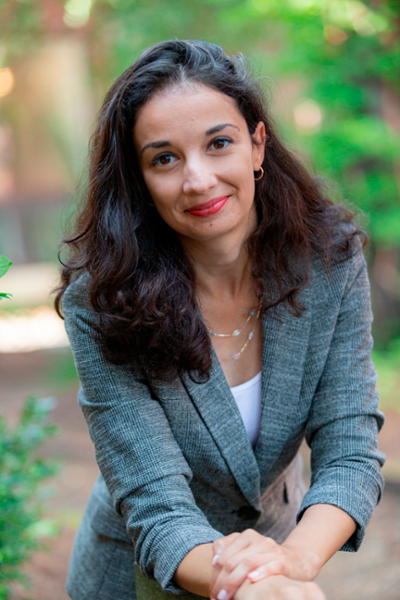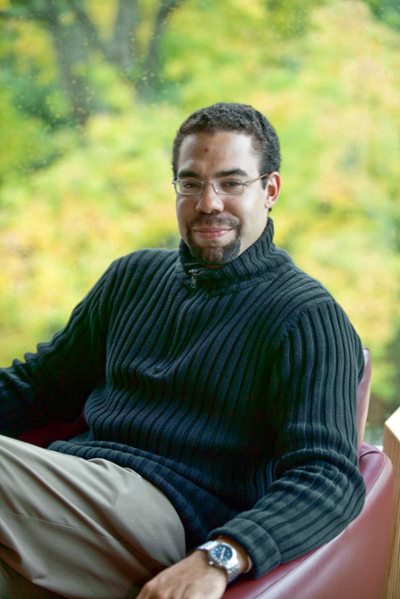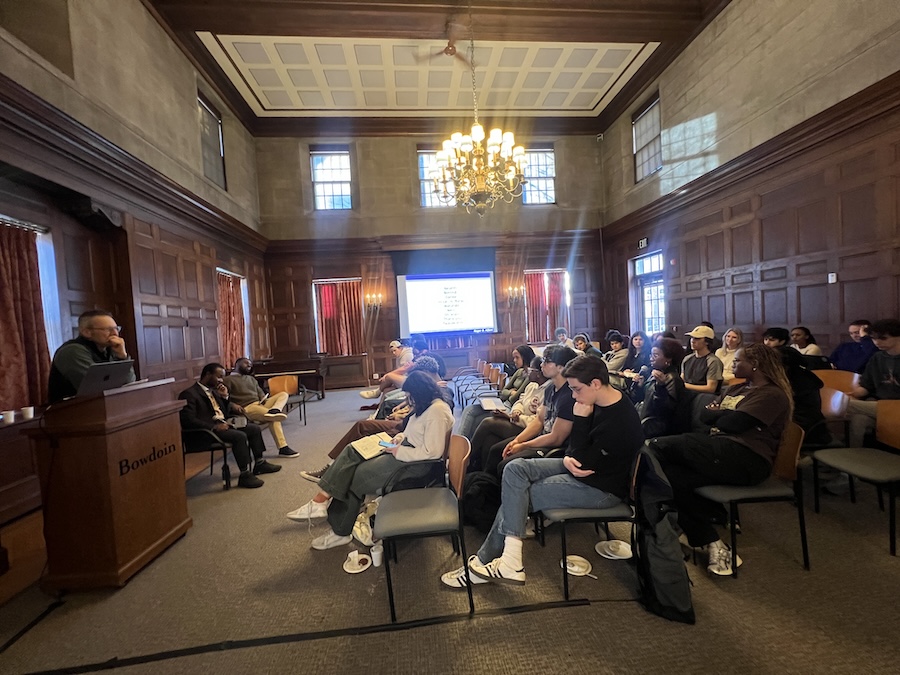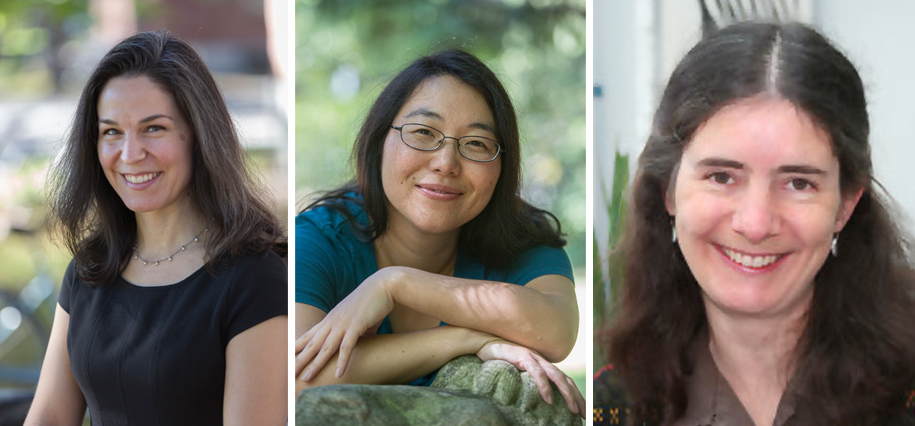Engaging with the Structures of Inequality: A Sample of DPI Courses
By Tom PorterA new type of course, aimed at helping students engage more with power structures of inequality, was introduced to the Bowdoin curriculum this semester. Difference, Power, and Inequity (DPI) classes fulfill a new distribution requirement being phased in this year and next to replace the ESD (Exploring Social Differences) requirement. Here we look at three of those new courses, two of which will be taught next semester and one of which was offered this semester.

Next semester, William D. Shipman Professor of Economics John Fitzgerald will be teaching Geographic Inequality, Public Policy, and GIS (ECON 3515). Fitzgerald is a key advocate of the requirement and played an important role in helping faculty colleagues familiarize themselves with the DPI concept and how they might engage with the new criteria.
"The daily news shows us that forces of intolerance and racism are not fading away,” he said. “To confront this, the times require that we all improve our ability to analyze these topics and respond.” Fitzgerald describes the DPI requirement as a step toward encouraging students and faculty members to investigate how differences across social groups are related to power and unfairness. “A goal is to equip students with skills needed to analyze causes and consequences of difference. The courses are also intended to encourage reflection about students’ own experiences with these topics,” he added.
Fitzgerald says this particular data-driven course aims to “hook students into how policy can improve society or harm it,” as well as offer an introduction to the use of geographic information systems (GIS) in the field of economics. “Geography affects economic inequality through its impact on resources, market prices, cultural influences like discrimination, demographics, and available technology. The course develops mapping and statistical tools to measure inequality, analyze its causes and effects, and evaluate the impacts of selected public policy interventions.” Topics planned so far, says Fitzgerald, include explaining the spatial distribution of poverty and income mobility, housing segregation and redlining, inequality in health outcomes across groups, pollution and toxic waste impacts by race and class, crime and policing issues, and schooling inequalities across groups.

Another new course coming up in the spring is The Egalitarian Empire: Ethnicity and Otherness in the Soviet Union (and Beyond) (RUS 2255), taught by Visiting Lecturer in Russian Miroslava Nikolova. This course will examine the experience of the Soviet Union's ethnic groups through literature and film. “What many people don’t realize today is that, during the early years of the Soviet Union, there was actually a real effort to encourage everyone within its borders to embrace their ethnic identity,” says Nikolova. Of course, she explains, this wasn’t done to encourage nationalism, but to reinforce the idea that the Soviet Union welcomes all groups. “This approach even extended to allowing schools to teach classes in their own languages, rather than Russian.” Even into the 1960s, Soviet leaders continued to celebrate the perceived harmonious internationalism of the USSR, using it as a Cold War propaganda tool against the US, which was beset by civil-rights-inspired unrest and division at the time.
While there is an element of truth to this propagandized narrative, she adds, the reality was of course much harsher, says Nikolova. This was especially the case under Stalin’s regime, when millions of citizens from various ethnic groups were forcibly deported to different parts of the Soviet Union. Hence the degree of irony she says is implicit in the course title The Egalitarian Empire. The class, to be conducted in English, will include a number of primary texts by authors from different cultures within the Soviet empire, explains Nikolova. “We’re lucky that more and more of these works have been translated into English in recent years. One text we’ll be reading is an anthology called The Way of Kinship, which features a variety of work by indigenous Siberian authors—there’s poetry, drama, fiction, memoir.” Among the films being analyzed by the class is Dersu Uzala (1975), by Japanese director Akira Kurosawa. “The movie follows a native Siberian man and his interactions with a Soviet survey mapping team. It’s a great examination of how the forces of modernization can encroach on a centuries-old habitat and lifestyle.”
Using a postcolonial lens, the course will investigate how the complex interactions between power, privilege, policy, colonizer, and colonized shaped the experience of Soviet "others" (who did not identify as ethnic Russians), Nikolova says. She also wants to encourage students to reflect on difference, diversity, and inclusion in both Russian and US contexts.

This semester, Geoffrey Canada Associate Professor of Africana Studies and History Brian Purnell has been teaching Racial and Ethnic Conflict in US Cities (HIST 1320/AFRS 1320/URBS 1320). “This is a very difficult subject to study and to teach,” he says. “We examine in detail the interracial violence that has plagued American society for the past century and a half and is still very much front and center today.” Subjects covered included the white supremacist reign of terror in 1919 known as the Red Summer and the Tulsa race massacre of 1921, through to the civil rights disturbances of the 1960s, the LA riots of 1992, and the more recent violence that led to the rise of the Black Lives Matter movement.
“Let me give a concrete example of why this is a challenging course,” continues Purnell. “One of the topics we cover is the history of racial lynching in the US, and many of the historical sources on this subject are photographs. So, we study them, and they’re hard to look at because of the level of brutality they show.” This is an especially difficult subject to tackle in the DPI context, explains Purnell, because it requires personal engagement from the student. “I invited the students to view these photographs, first from their own perspective as an American college student in 2021, but also from the perspective of someone who was there at time, either the victim of the violence, the photographer who recorded the event, or—and this is the really difficult one—from the perspective of someone in the lynch mob.”
It may sound repellent to ask a student to see things from the point of view of a supporter of such violence, says Purnell, but there is good reason for it. “If we don't understand that perspective, within this context of torture and racism and violence, then how can we really understand how these practices continue today?” Real life is complicated, he says, and rarely simply a case of good versus bad, or right versus wrong, and this exercise is designed to help students understand that.
“On a basic level, we look at social power differences that result in violence. That’s the context. Then we go to the next step and try to understand how that context was experienced from people on all sides. What I take away from this is that the ultimate responsibility lies with the perpetrators of the violence, but it's our responsibility to make sense of it all.”
Bowdoin requires students to complete at least one full-credit course in each of five distribution areas: Mathematical, Computational, or Statistical Reasoning; Inquiry in the Natural Sciences; International Perspectives; Visual and Performing Arts; and DPI (currently being phased in to replace ESD). This requirement should normally be completed by the end of a student’s fourth semester.



